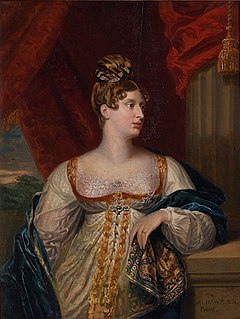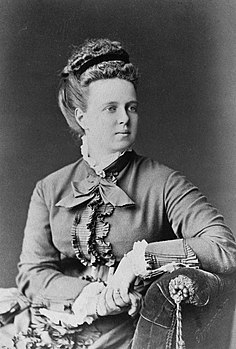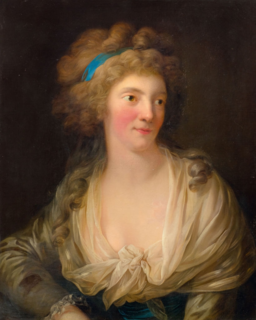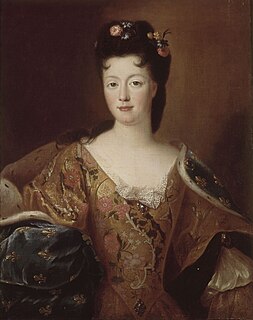Related Research Articles

Emily Jane Brontë was an English novelist and poet who is best known for her only novel, Wuthering Heights, now considered a classic of English literature. She also published a book of poetry with her sisters Charlotte and Anne titled Poems by Currer, Ellis and Acton Bell with her own poems finding regard as poetic genius. Emily was the second-youngest of the four surviving Brontë siblings, between the youngest Anne and her brother Branwell. She published under the pen name Ellis Bell.

Caroline of Brunswick was Queen of the United Kingdom and Hanover as the wife of King George IV from 29 January 1820 until her death in 1821. She was Princess of Wales from 1795 to 1820.

Philippe II, Duke of Orléans, was a French royal, soldier, and statesman who served as Regent of the Kingdom of France from 1715 to 1723. He is also referred to as le Régent. He was the son of Monsieur Philippe I, Duke of Orléans, and the Duchess Madame Elisabeth Charlotte. Born at his father's palace at Saint-Cloud, he was known from birth under the title of Duke of Chartres.

Francis I was the Duke of Lorraine and Bar (1729–1737), and later Grand Duke of Tuscany (1737–1765), who married Maria Theresa of Austria and became the last non-Habsburg Holy Roman Emperor (1745–1765) and Archduke of Austria (1740–1765). His wife effectively ruled Austria and the Holy Roman Empire. They were the founders of the Habsburg-Lorraine dynasty. The oldest surviving son of Leopold, Duke of Lorraine, Francis left the duchy for the deposed Polish king Stanisław Leszczyński in exchange for the Grand Duchy of Tuscany as one of the terms ending the War of the Polish Succession in 1738. The duchy and the ducal title to Lorraine and Bar passed to King Louis XV of France upon Leszczynski's death in 1766, though Francis and his successors retained the right to style themselves as dukes of Lorraine and Bar.

Princess Charlotte of Wales was the only child of George, Prince of Wales, and his wife, Caroline of Brunswick. Had she outlived both her grandfather King George III and her father, she would have become Queen of the United Kingdom; but she died at the age of 21, predeceasing them both.

The Brontës were a nineteenth-century literary family, born in the village of Thornton and later associated with the village of Haworth in the West Riding of Yorkshire, England. The sisters, Charlotte (1816–1855), Emily (1818–1848), and Anne (1820–1849), are well known as poets and novelists. Like many contemporary female writers, they originally published their poems and novels under male pseudonyms: Currer, Ellis, and Acton Bell. Their stories immediately attracted attention for their passion and originality. Charlotte's Jane Eyre was the first to know success, while Emily's Wuthering Heights, Anne's The Tenant of Wildfell Hall and other works were later to be accepted as masterpieces of literature.

Grand Duchess Maria Alexandrovna of Russia, later Duchess of Edinburgh and Duchess of Saxe-Coburg and Gotha, was the fifth child and only surviving daughter of Emperor Alexander II of Russia and his first wife, Princess Marie of Hesse and by Rhine. She was the younger sister of Alexander III of Russia and the paternal aunt of Russia's last emperor, Nicholas II.

Maria Amalia Teresa of Naples and Sicily was a French queen by marriage to Louis Philippe I, King of the French. She was the last queen in France.

Louis Joseph de Bourbon was Prince of Condé from 1740 to his death. A member of the House of Bourbon, he held the prestigious rank of Prince du Sang.

Marie-Thérèse, Duchess of Angoulême was the eldest child of Louis XVI and Marie Antoinette, and the only one to reach adulthood. She was married to Louis Antoine, Duke of Angoulême, who was the eldest son of the future Charles X, her father's younger brother; thus the bride and groom were also first cousins.

Kew Palace is a British royal palace within the grounds of Kew Gardens on the banks of the River Thames. Originally a large complex, few elements of it survive. Dating to 1631 but built atop the undercroft of an earlier building, the main survivor is known as the Dutch House. Its royal occupation lasted from around 1728 until 1818, with a final short-lived occupation in 1844. The Dutch House is Grade I listed, and open to visitors. It is cared for by an independent charity, Historic Royal Palaces, which receives no funding from the government or the Crown. Alongside the Dutch House is a part of its 18th-century service wing, whilst nearby are a former housekeeper's cottage, brewhouse and kitchen block – most of these buildings are private, though the kitchens are open to the public. These kitchens and Queen Charlotte's Cottage are also run by Historic Royal Palaces.

Princess Frederica Charlotte of Prussia was a Prussian and British princess. She was the eldest daughter of King Frederick William II of Prussia and the wife of Prince Frederick, Duke of York and Albany, second son of King George III of the United Kingdom.

Princess Augusta Frederica of Great Britain was a British princess, granddaughter of King George II and the only elder sibling of King George III. She was the duchess of Brunswick-Wolfenbuttel by marriage to Charles William Ferdinand, Duke of Brunswick. Her daughter Caroline was the spouse of King George IV.
In law a settlor is a person who settles property on trust law for the benefit of beneficiaries. In some legal systems, a settlor is also referred to as a trustor, or occasionally, a grantor or donor. Where the trust is a testamentary trust, the settlor is usually referred to as the testator. The settlor may also be the trustee of the trust or a third party may be the trustee. In the common law of England and Wales, it has been held, controversially, that where a trustee declares an intention to transfer trust property to a trust of which he is one of several trustees, that is a valid settlement notwithstanding the property is not vested in the other trustees.

Charlotte Aglaé d'Orléans, was the Duchess of Modena and Reggio by marriage. She was the third daughter of Philippe II, Duke of Orléans, and of his wife, Françoise-Marie de Bourbon. She was born a princesse du sang. She had ten children.

Élisabeth Charlotte d'Orléans was a petite-fille de France, and duchess of Lorraine and Bar by marriage to Leopold, Duke of Lorraine. She was regent of Lorraine and Bar during the minority (1729–1730) and absence of her son (1730–1737), and suo jure Princess of Commercy 1737–1744. Among her children was Francis I, Holy Roman Emperor, a co-founder of the royal House of Habsburg-Lorraine.

Anne Charlotte of Lorraine was the Abbess of Remiremont and Mons. She was the thirteenth of fifteen children of Leopold, Duke of Lorraine, and his spouse Élisabeth Charlotte d'Orléans. Her mother was the niece of Louis XIV of France and sister of Philippe II, Duke of Orléans and Regent of France during the minority of Louis XV.

Hussey v Palmer [1972] EWCA Civ 1 is an English trusts law case of the Court of Appeal. It concerned the equitable remedy of constructive trusts. It invokes the equitable maxim, "equity regards the substance and not the form."
Maria Aurora Uggla, married name Ehrengranat (1747–1826), was a Swedish lady in waiting and noble. She was the lady in waiting and confidant of the Swedish Queen, Sophia Magdalena of Denmark, and later the head of the court of Crown Prince Gustav Adolf.

Henrietta Anne of England was the youngest daughter of King Charles I of England and Queen Henrietta Maria.